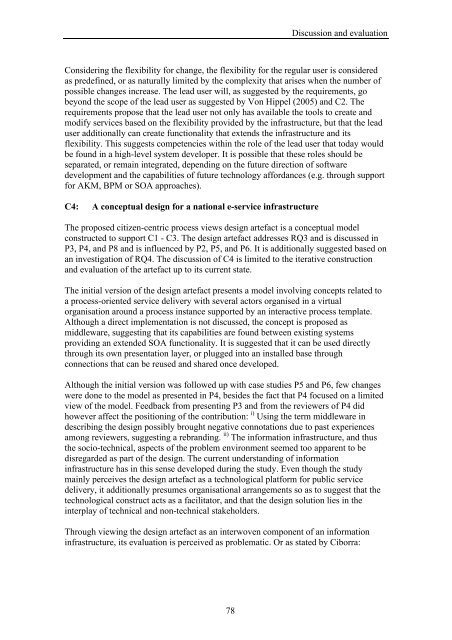Multi-channel provisioning of public services - Department of ...
Multi-channel provisioning of public services - Department of ...
Multi-channel provisioning of public services - Department of ...
Create successful ePaper yourself
Turn your PDF publications into a flip-book with our unique Google optimized e-Paper software.
Discussion and evaluation<br />
Considering the flexibility for change, the flexibility for the regular user is considered<br />
as predefined, or as naturally limited by the complexity that arises when the number <strong>of</strong><br />
possible changes increase. The lead user will, as suggested by the requirements, go<br />
beyond the scope <strong>of</strong> the lead user as suggested by Von Hippel (2005) and C2. The<br />
requirements propose that the lead user not only has available the tools to create and<br />
modify <strong>services</strong> based on the flexibility provided by the infrastructure, but that the lead<br />
user additionally can create functionality that extends the infrastructure and its<br />
flexibility. This suggests competencies within the role <strong>of</strong> the lead user that today would<br />
be found in a high-level system developer. It is possible that these roles should be<br />
separated, or remain integrated, depending on the future direction <strong>of</strong> s<strong>of</strong>tware<br />
development and the capabilities <strong>of</strong> future technology affordances (e.g. through support<br />
for AKM, BPM or SOA approaches).<br />
C4: A conceptual design for a national e-service infrastructure<br />
The proposed citizen-centric process views design artefact is a conceptual model<br />
constructed to support C1 - C3. The design artefact addresses RQ3 and is discussed in<br />
P3, P4, and P8 and is influenced by P2, P5, and P6. It is additionally suggested based on<br />
an investigation <strong>of</strong> RQ4. The discussion <strong>of</strong> C4 is limited to the iterative construction<br />
and evaluation <strong>of</strong> the artefact up to its current state.<br />
The initial version <strong>of</strong> the design artefact presents a model involving concepts related to<br />
a process-oriented service delivery with several actors organised in a virtual<br />
organisation around a process instance supported by an interactive process template.<br />
Although a direct implementation is not discussed, the concept is proposed as<br />
middleware, suggesting that its capabilities are found between existing systems<br />
providing an extended SOA functionality. It is suggested that it can be used directly<br />
through its own presentation layer, or plugged into an installed base through<br />
connections that can be reused and shared once developed.<br />
Although the initial version was followed up with case studies P5 and P6, few changes<br />
were done to the model as presented in P4, besides the fact that P4 focused on a limited<br />
view <strong>of</strong> the model. Feedback from presenting P3 and from the reviewers <strong>of</strong> P4 did<br />
however affect the positioning <strong>of</strong> the contribution: i) Using the term middleware in<br />
describing the design possibly brought negative connotations due to past experiences<br />
among reviewers, suggesting a rebranding. ii) The information infrastructure, and thus<br />
the socio-technical, aspects <strong>of</strong> the problem environment seemed too apparent to be<br />
disregarded as part <strong>of</strong> the design. The current understanding <strong>of</strong> information<br />
infrastructure has in this sense developed during the study. Even though the study<br />
mainly perceives the design artefact as a technological platform for <strong>public</strong> service<br />
delivery, it additionally presumes organisational arrangements so as to suggest that the<br />
technological construct acts as a facilitator, and that the design solution lies in the<br />
interplay <strong>of</strong> technical and non-technical stakeholders.<br />
Through viewing the design artefact as an interwoven component <strong>of</strong> an information<br />
infrastructure, its evaluation is perceived as problematic. Or as stated by Ciborra:<br />
78
















